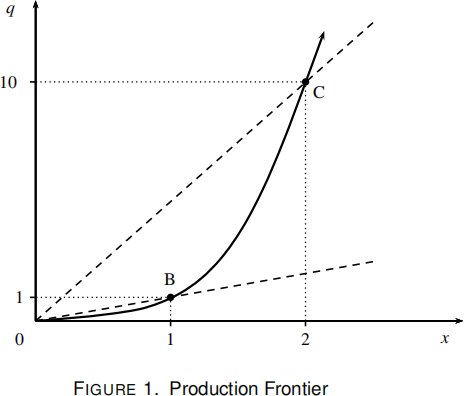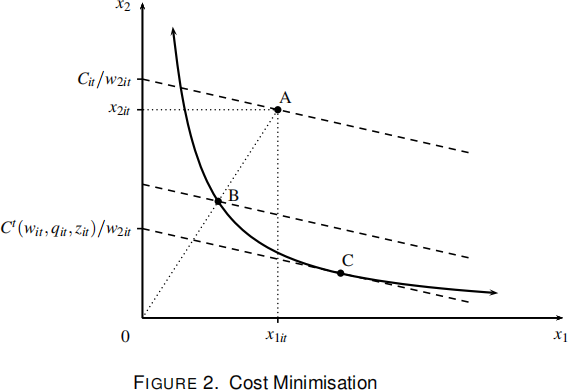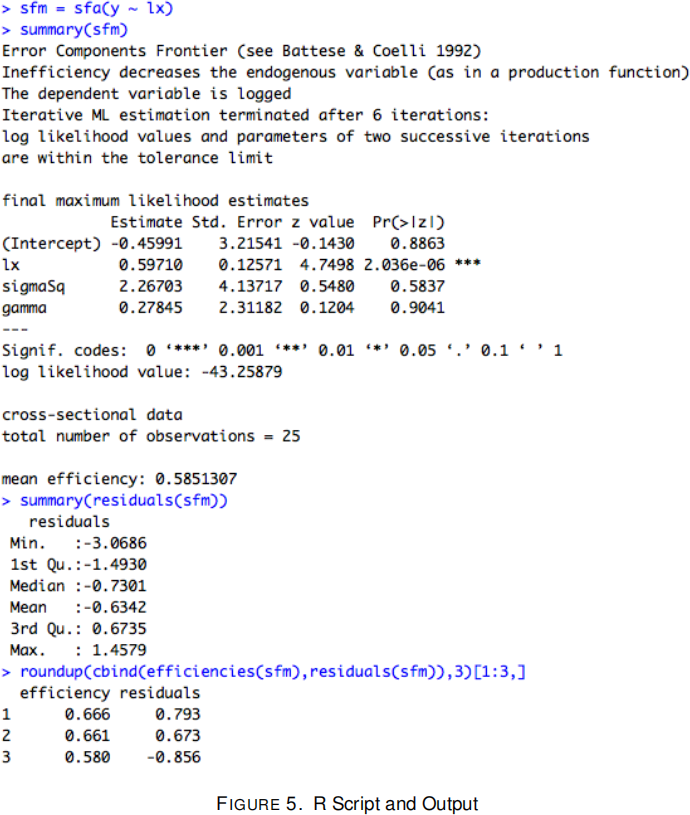ECON7341 Productivity and Efficiency Analysis Semester Two Final Examination, 2019
Hello, dear friend, you can consult us at any time if you have any questions, add WeChat: daixieit
Semester Two Final Examination, 2019
ECON7341 Productivity and Efficiency Analysis
ANSWER ALL QUESTIONS ON THE MULTIPLE CHOICE ANSWER SHEET
EACH QUESTION IS WORTH 4 MARKS (TOTAL 100 MARKS)
1) It is common to assume that input sets are convex. This assumption says that:
(a) if an output vector can be produced using two different input vectors, then it can also be produced using a convex combination of those input vectors.
(b) if inputs are increased by one percent, then outputs can be increased by r percent.
(c) if an input vector can be used to produce two different output vectors, then it can also be used to produce a convex combination of those output vectors.
(d) if a non-zero input vector can be used to produce a non-zero output vector, then any scalar magnification of that output vector is attainable by a suitable scalar
magnification of the input vector.
(e) None of the above.
2) An output distance function gives:
(a) the reciprocal of the largest factor by which it is possible to scale up a given output vector when using given inputs.
(b) the largest factor by which it is possible to scale down a given input vector when producing given outputs.
(c) the minimum cost of producing a given output vector when inputs can be chosen freely.
(d) the maximum revenue that can be obtained using given inputs when the output
mix is fixed.
(e) None of the above.
3) The production frontier passing through points B and C in Figure 1 exhibits:
(a) increasing returns to scale.
(b) constant returns to scale.
(c) decreasing returns to scale.
(d) variable returns to scale.
(e) None of the above.

4) An analyst has used five indices to measure changes in the output quantities reported in the first two columns of Table 1. The only proper index numbers are those reported in:
(a) column A .
(b) column B.
(c) column C.
(d) column D.
(e) None of the above.
TABLE 1. Quantity Index Numbers
|
Output 1 |
Output 2 |
A |
B |
C |
D |
|
0.42 |
0.23 |
1.000 |
1.000 |
1.000 |
1.000 |
|
1.83 |
1.41 |
5.393 |
5.393 |
5.174 |
5.395 |
|
0.09 |
0.06 |
0.242 |
0.243 |
0.237 |
0.242 |
|
0.04 |
0.18 |
0.320 |
0.326 |
0.275 |
0.340 |
|
0.85 |
4.96 |
8.138 |
8.112 |
6.656 |
8.864 |
|
0.18 |
0.12 |
0.460 |
1.216 |
0.474 |
0.460 |
5) All proper input quantity indexes satisfy the following axioms:
(a) transitivity and time-space reversal.
(b) proportionality.
(c) weak monotonicity.
(d) All of the above.
(e) None of the above.
6) If observed output prices are firm- and time-invariant, then:
(a) Fisher output index numbers are equal to Lowe output index numbers.
(b) Tornqvist output index numbers are equal to geometric Young output index numbers. (c) EKS output index numbers are equal to CCD output index numbers.
(d) All of the above.
(e) None of the above.
7) The cost minimisation problem faced by firm i in period t is depicted in Figure 2. If the firm was a price-taker in input markets and its outputs and input mix had been predetermined, then it could have minimised the cost of producing its outputs by operating at:
(a) the origin.
(b) point A.
(c) point B.
(d) point C.
(e) None of the above.

8) Consider the following optimisation problem:
 (1)
(1)
where pn denotes then-th output price, gn denotes then-th output quantity, yj denotes the j-th environmental variable, and wm denotes them-th input quantity. If all output prices, input quantities and environmental variables are positive, then:
(a) there is no feasible solution.
(b) there may be more than one output vector that solves this problem. (c) the feasible region is unbounded.
(d) the optimised value of the objective function is a measure of revenue efficiency. (e) None of the above.
9) The output-oriented mixefficiency of a manager can be viewed as:
(a) a proper output index.
(b) a proper TFP index.
(c) a measure of how well the manager has captured economies of output substitution. (d) All of the above.
(e) None of the above.
10) Which of the following statements is true?
(a) The cost-allocative efficiency of a firm is a measure of how well the manager has captured economies of input substitution.
(b) Economies of scale are the benefits obtained by changing the scale of a firms operations.
(c) DEA estimates of scale efficiency can be obtained by dividing estimates of technical efficiency obtained under a CRS assumption by estimates of technical efficiency
obtained under a VRS assumption.
(d) All of the above.
(e) None of the above.
11) An important assumption underpinning piecewise frontier analysis is that:
(a) all environmental variables are observed and measured without error. (b) production frontiers are locally linear.
(c) outputs and inputs are weakly disposable.
(d) All of the above.
(e) None of the above.
12) An analyst has been given data on I firms over T time periods and has been asked to solve the following linear program:

where git is a vector of outputs, wit is a vector of inputs, and yit is a vector of environmental variables. The maximised value of the objective function is an estimate of:
(a) output-oriented technical efficiency.
(b) input-oriented technical efficiency.
(c) revenue efficiency.
(d) profitefficiency.
(e) None of the above.
13) Which of the following statements is true?
(a) Standard DEA estimators of efficiency are generally biased in finite samples, even if the assumptions underpinning the DEA model are true.
(b) Every primal DEA problem has a dual form with the property that if the primal and dual problems have a feasible solution, then the optimised values of objective functions are equal.
(c) DEA estimation often involves choosing the parameters of the output distance function so that the estimated production frontier envelops the observed data as tightly as possible.
(d) All of the above.
(e) None of the above.
14) An analyst is interested in evaluating the performance of a group of five car manufacturers. Inputs and outputs for the manufacturers are presented in Table 2. The analyst
assumes the production frontier exhibits constant returns to scale. She then uses the Benchmarking package in R to obtain the results presented in Figure 3. The output-oriented technical efficiency of manufacturer B is:
(a) 0.536.
(b) 0.991.
(c) 1.000.
(d) unable to be determined from the information given.
(e) None of the above.

15) Consider the following DEA model:
min μ
s.t. 3λ1 + 2λ2 + 2λ3 + 1λ4 > 3 (output 1)
3λ1 + 2λ2 + 2λ3 + 1λ4 > 3 (output 2)
6μ - 6λ1 - 2λ2 - 6λ3 - 5λ4 > 0 (input 1)
9μ - 9λ1 - 6λ2 - 3λ3 - 2λ4 > 0 (input 2)
λ 1 , . . . , λ4 > 0
The values of the decision variables at the optimum are (μ, λ1 , λ2 , λ3 , λ4 ) = (0.833, 0, 1, 0.5, 0). The output-oriented technical efficiency of the firm being evaluated is:
(a) 0.5.
(b) 0.833.
(c) 1.
(d) unable to be determined from the information given.
(e) None of the above.
16) Consider the deterministic frontier model gi = a + β ln ①i - ui where gi denotes the logarithm of the output of firm i, ①i is an associated pre-determined input, and ui is an independent gamma random variable with shape parameter P < 2 and scale parameter σu. Which of the following statements is true?
(a) The ordinary least squares estimator for a is biased.
(b) The COLS estimator for β is asymptotically efficient.
(c) The maximum likelihood estimator for β is asymptotically normal.
(d) All of the above.
(e) None of the above.
17) Consider the following relationship:
gi = 6 + 0.2 ln ①1i + 0.3 ln ①2i 4 ui
where gi denotes the logarithm of the output of firm i, ①1i and ①2i denote inputs of capital and labour, and ui is a nonnegative output-oriented technical inefficiency effect. Consider a firm that uses one unit of capital and two units of labour to produce fiftyunits of output. The input-oriented technical efficiency of the manager is (rounded to three decimal places):
(a) 0.010.
(b) 0.101.
(c) 0.436.
(d) 0.632.
(e) None of the above.
18) Consider the following output-oriented deterministic frontier model:

where git is the logarithm of the output of firm i in period t, ①mit is them-th associated input, and uit is a nonnegative independent random variable with E(uit ) = μ and uaT (uit ) K σu(2) for all i and t. A researcher has used 100 observations to test for fixed effects. He has used R to generate the results in Figure 4. On the basis of these results, he should:
(a) reject the null hypothesis at the 5% level of significance.
(b) not reject the null hypothesis at the 5% level of significance.
(c) accept the null hypothesis at the 5% level of significance.
(d) conduct a likelihood ratio test.
(e) None of the above.

19) Leoni Leonly has used a Lowe TFP index to measure changes in the productivity of several single-input-single-output firms. She intends to explain variations in her index numbers using the following output-oriented deterministic frontier model:
lngit = a + oyit + glnwit 4 uit
where git is the output of firm i in period t, wit is the associated input, yit is an environmental variable, and uit > 0 is a measure of output-oriented technical efficiency. By using this model, she will potentially be attributing changes in her TFP index numbers to:
(a) environmental change.
(b) technical efficiency change.
(c) scale efficiency change.
(d) All of the above.
(e) None of the above.
20) Consider the following output-oriented stochastic frontier model:
lngi = a + glnwi + oi 4 ui
where gi is the output of firm i, wi is the associated input, oi represents statistical noise, and ui > 0 is a random variable representing technical inefficiency. Arthur Dent has used observations on twenty-five firms to estimate the parameters of this model. The results are reported in Figure 5. Arthur subsequently uses these results to estimate the statistical noise component. His estimate of o2 is:
(a) 0.585.
(b) 0.673.
(c) 1.247.
(d) 1.259.
(e) None of the above.
21) Compared to piecewise frontier analysis, one of the disadvantages of stochastic frontier analysis is that:
(a) estimation requires stronger assumptions about the probability distributions of random variables representing statistical noise.
(b) the estimated parameters of stochastic frontier functions cannot be used to compute (proper) primal or dual productivity index numbers.
(c) researchers must assume that the functional forms of relevant distance, revenue, cost and/or profit functions are known.
(d) All of the above.
(e) None of the above.
22) Which of the following is a source of statistical noise in a revenue-oriented stochastic frontier model:
(a) an omitted output quantity.
(b) an included environmental variable.
(c) the use of a translog functional form.
(d) All of the above.
(e) None of the above.

23) Consider a system of equations with the following structure:
git = ft (①it ) + uit - uit (1)
and uit = gt (从it ) + 山it (2)
where git is the logarithm of output, ①it is a vector of inputs, 从it is a vector of environmental variables, uit > 0 is an output-oriented technical inefficiency effect, and uit and 山it
are variables that account for statistical noise. Which of the following statements is true?
(a) If environmental variables are observed, then failure to include them in (1) is an omitted variable error.
(b) If outputs and inputs are observed, then failure to include them in (2) is an omitted variable error.
(c) If environmental variables are involved in the production process, then the system defined by (1) and (2) is misspecified.
(d) All of the above.
(e) None of the above.
24) An analyst believes the relationship between the outputs and inputs of a particular firm is given by:
ln qt = 5 + 0.1t + 0.6 ln ①t + ut - ut
where qt denotes output in year t, ①t denotes the associated input, ut is a measure of statistical noise, and ut > 0 is an output-oriented technical inefficiency effect. Suppose the firm uses one unit of input to produce one unit of output in year 1, and two units of input to produce seven units of output in year 5. If there is no change in statistical noise, then the analyst can safely conclude that the productivity of the firm has increased:
(a) despite a 24.2% decrease in output-oriented scale and mixefficiency. (b) partly due to technical progress at the rate of 1% per year.
(c) partly due to an increase in output-oriented mixefficiency.
(d) All of the above.
(e) None of the above.
25) Which of the following steps should come first in a policy-oriented analysis of firm performance?
(a) Assemble relevant data.
(b) Classify the variables that are physically involved in the production process. (c) Choose an estimation approach.
(d) Select functions to represent production possibilities sets.
(e) Make assumptions about production technologies.
2023-06-10